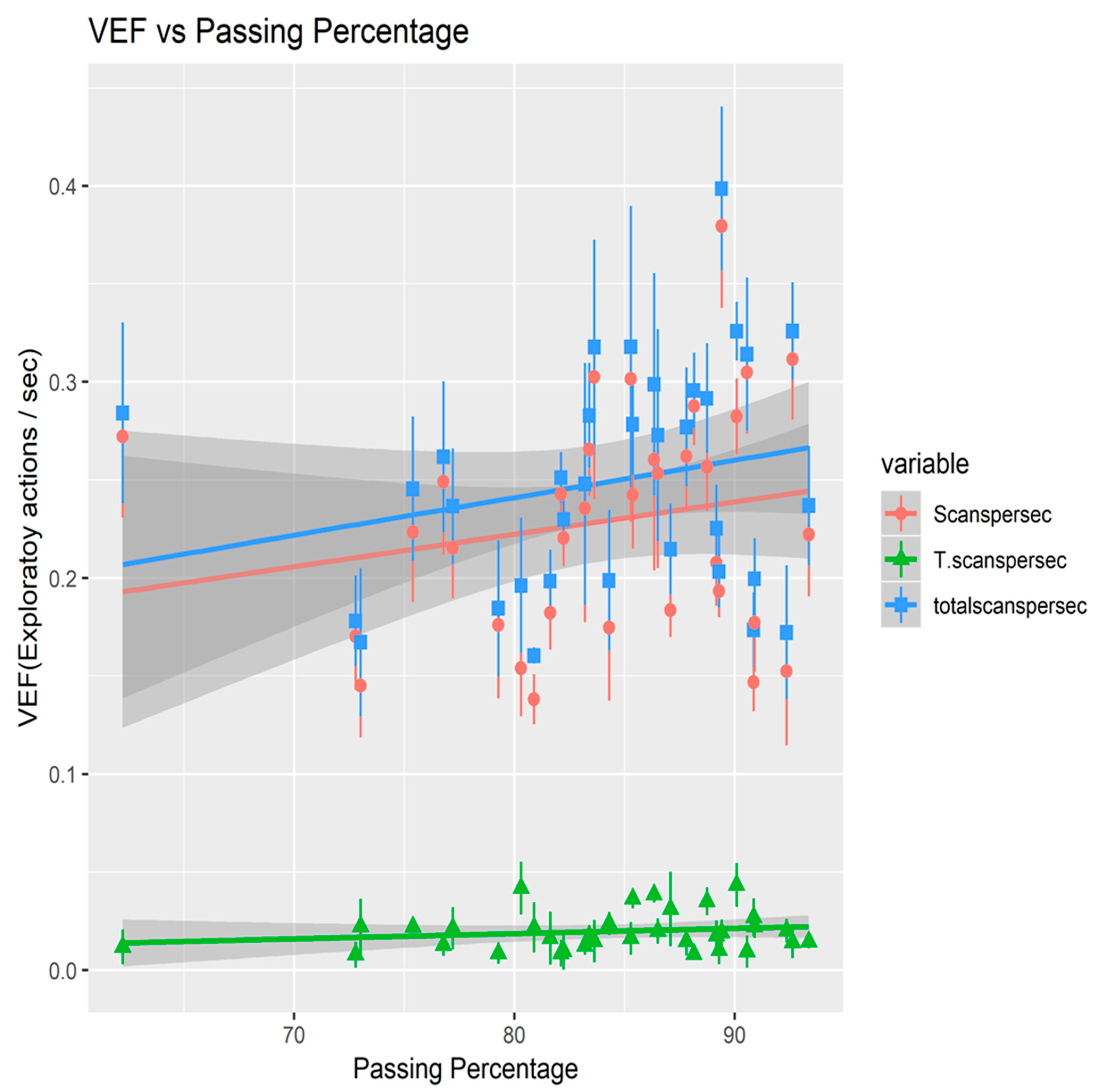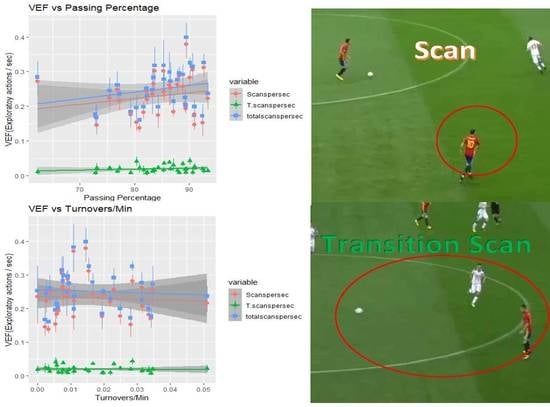Keep Your Head Up—Correlation between Visual Exploration Frequency, Passing Percentage and Turnover Rate in Elite Football Midfielders
Abstract
:1. Introduction
2. Materials and Methods
2.1. Study Design
2.2. Statistics
2.3. Interrater Reliability
3. Results
3.1. Average Passing Percentage vs VEF
3.2. VEF vs. Turnovers Per Minute
4. Discussion
Limitations
5. Conclusions
Author Contributions
Funding
Conflicts of Interest
Appendix A
- Belgium: Kevin De Bruyne, Axel Witsel, Radja Nainggolan
- Croatia: Luka Modric, Ivan Rakitic, Milan Badelj
- England: Wayne Rooney, Eric Dier, Dele Alli
- Germany: Toni Kroos, Mesut Özil, Sami Khedira
- Hungry: Zoltán Gera, Ádám Nagy
- Iceland: Gylfi Sigurdsson, Aron Gunnarsson
- Ireland: James McCarthy
- Italy: Daniele De Rossi
- N. Ireland: Steven Davis, Corry Evans
- Poland: Grzegorz Krychowiak, Krzysztof Maczynski
- Portugal: Adrien Silva, João Moutinho
- Slovakia: Marek Hamsik, Juraj Kucka
- Spain: Andrés Iniesta, Cesc Fàbregas, Sergio Busquets
- Switzerland: Granit Xhaka, Valon Behrami, Blerim Dzemaili
- Wales: Aaron Ramsey, Joe Allen, Joe Ledley
Appendix B
- Daniele De Rossi: Italy versus Belgium,
- Radja Nainggolan: Belgium versus Italy,
- João Moutinho: Portugal versus Austria,
- Zoltán Gera: Hungary versus Iceland, and
- Axel Witsel: Belgium versus Ireland.
References
- Hughes, M.; Caudrelier, T.; James, N.; Donnelly, I.; Kirkbride, A.; Duschesne, C. Moneyball and soccer—An analysis of the key performance indicators of elite male soccer players by position. J. Hum. Sport Exerc. 2012, 7, 402–412. [Google Scholar] [CrossRef]
- Abernethy, B.; Gill, D.P.; Parks, S.L.; Packer, S.T. Expertise and the perception of kinematic and situational probability information. Perception 2001, 30, 233–252. [Google Scholar] [CrossRef] [PubMed]
- Pocock, C.; Dicks, M.; Thelwell, R.C.; Chapman, M.; Barker, J.B. Using an imagery intervention to train visual exploratory activity in elite academy football players. J. Appl. Sport Psychol. 2019, 31, 218–234. [Google Scholar] [CrossRef]
- Ward, P.; Williams, A.M. Perceptual and cognitive skill development in soccer: the multidimensional nature of expert performance. J. Sport Exerc. Psychol. 2003, 25, 93–111. [Google Scholar] [CrossRef]
- Williams, A.M.; Hodges, N.J.; North, J.S.; Barton, G. Perceiving patterns of play in dynamic sport tasks: investigating the essential information underlying skilled performance. Perception 2006, 35, 317–332. [Google Scholar] [CrossRef] [PubMed]
- Faubert, J. Professional athletes have extraordinary skills for rapidly learning complex and neutral dynamic visual scenes. Sci. Rep. 2013, 3, 1154. [Google Scholar] [CrossRef] [PubMed]
- Rein, R.; Raabe, D.; Memmert, D. “Which pass is better?” Novel approaches to assess passing effectiveness in elite soccer. Hum. Mov. Sci. 2017, 55, 172–181. [Google Scholar] [CrossRef] [PubMed]
- Williams, A.M.; Davids, K.; Burwitz, L.; Williams, J.G. Visual search strategies in experienced and inexperienced soccer players. Res. Q. Exerc. Sport 1994, 65, 127–135. [Google Scholar] [CrossRef] [PubMed]
- Tedesqui, R.A.B.; Orlick, T. Brazilian elite soccer players: Exploring attentional focus in performance tasks and soccer positions. Sport Psychol. 2015, 29, 41–50. [Google Scholar] [CrossRef]
- Smith, M.D.; Chamberlin, C.J. Effect of adding cognitively demanding tasks on soccer skill performance. Percept. Mot. Skills 1992, 75, 955–961. [Google Scholar] [CrossRef]
- Williams, A.M.; Davids, K. Visual search strategy, selective attention, and expertise in soccer. Res. Q. Exerc. Sport 1998, 69, 111–128. [Google Scholar] [CrossRef]
- McGuckian, T.B.; Cole, M.H.; Jordet, G.; Chalkley, D.; Pepping, G.-J. Don’t turn blind! The relationship between exploration before ball possession and on-ball performance in association football. Front. Psychol. 2018, 9, 2520. [Google Scholar] [CrossRef]
- Fagereng, K. A Real Game Examination of Visual Perception in Soccer; Norwehian School of Sports Sciences: Oslo, Norway, 2010. [Google Scholar]
- Jordet, G. Perceptual training in soccer: An imagery intervention study with elite players. J. Appl. Sport Psychol. 2005, 17, 140–156. [Google Scholar] [CrossRef]
- Krippendorff, K. Agreement and information in the reliability of coding. Commun. Methods Meas. 2011, 5, 93–112. [Google Scholar] [CrossRef]
- Saito, K.; Yoshimura, M. Pass appearance time and pass attempts by teams qualifying for the second stage of FIFA World Cup 2014 in Brazil. J. Sports Sci. 2016, 4, 156–162. [Google Scholar]
- Bialkowski, A.; Lucey, P.; Carr, P.; Yue, Y.; Sridharan, S.; Matthews, I. Large-Scale Analysis of Soccer Matches Using Spatiotemporal Tracking Data. In Proceedings of the 2014 IEEE International Conference on Data Mining, Shenzhen, China, 14–17 December 2014; pp. 725–730. [Google Scholar]
- Göral, K. One of the main determinants of performance in soccer: ball possession (Analysis of FIFA U-20 World Cup). Int. REFEREED J. Humanit. Acad. Sci. 2015, 4, 128. [Google Scholar] [CrossRef]
- Ward, P.; Hodges, N.J.; Starkes, J.L.; Williams, M.A. The road to excellence: deliberate practice and the development of expertise. High Abil. Stud. 2007, 18, 119–153. [Google Scholar] [CrossRef]
- Jordet, G.; Bloomfield, J.; Heijmerikx, J. The hidden foundation of field vision in English Premier League (EPL) soccer players. In Proceedings of the MIT Sloan Sports Analytics Conference, Boston, MA, USA, 1–2 March 2013. [Google Scholar]



| VEF | Estimate | Std. Error | t Value | R Squared (%) | P-Value | F-Value |
|---|---|---|---|---|---|---|
| Scans | 16.728 | 7.836 | 2.135 | 3.0% | 0.033 | 4.556 |
| Transition scans | 78.694 | 44.005 | 1.788 | 2.1% | 0.074 | 3.168 |
| Total scans | 19.181 | 7.837 | 2.448 | 4.0% | 0.015 | 6.049 |
| VEF | Estimate | Std. Error | t Value | R Squared (%) | P-Value | F-Value |
|---|---|---|---|---|---|---|
| Scans | 0.0037 | 0.0162 | 0.2314 | 0.04% | 0.8171 | 0.0529 |
| Transition scans | −0.2066 | 0.0908 | −2.2758 | 3.51% | 0.0233 | 5.3035 |
| Total scans | −0.0029 | 0.0162 | −00.1802 | 0.02% | 0.8571 | 0.0321 |
© 2019 by the authors. Licensee MDPI, Basel, Switzerland. This article is an open access article distributed under the terms and conditions of the Creative Commons Attribution (CC BY) license (http://creativecommons.org/licenses/by/4.0/).
Share and Cite
Phatak, A.; Gruber, M. Keep Your Head Up—Correlation between Visual Exploration Frequency, Passing Percentage and Turnover Rate in Elite Football Midfielders. Sports 2019, 7, 139. https://doi.org/10.3390/sports7060139
Phatak A, Gruber M. Keep Your Head Up—Correlation between Visual Exploration Frequency, Passing Percentage and Turnover Rate in Elite Football Midfielders. Sports. 2019; 7(6):139. https://doi.org/10.3390/sports7060139
Chicago/Turabian StylePhatak, Ashwin, and Markus Gruber. 2019. "Keep Your Head Up—Correlation between Visual Exploration Frequency, Passing Percentage and Turnover Rate in Elite Football Midfielders" Sports 7, no. 6: 139. https://doi.org/10.3390/sports7060139
APA StylePhatak, A., & Gruber, M. (2019). Keep Your Head Up—Correlation between Visual Exploration Frequency, Passing Percentage and Turnover Rate in Elite Football Midfielders. Sports, 7(6), 139. https://doi.org/10.3390/sports7060139







